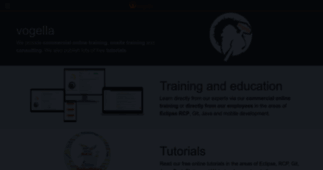Eclipse and Android Information
Enter a key term, phrase, name or location to get a selection of only relevant news from all RSS channels.
Enter a domain's or RSS channel's URL to read their news in a convenient way and get a complete analytics on this RSS feed.
Unfortunately Eclipse and Android Information has no news yet.
But you may check out related channels listed below.
[...] This tutorial describes how to use Eclipse BIRT for reporting on simple Java Objects (POJO's). The tutorial [...]
[...] This tutorial describes the creation of live wallpapers for Android. It is based on Eclipse 4.2, Java 1.6 and [...]
[...] This tutorial describes how to schedule tasks in Android. It looks at the AlarmManager as well on the JobScheduler [...]
[...] This tutorial describes how the Android application and activity lifecycle works. [...]
[...] This tutorial explains the usage of Eclipse JFace TableViewer including label and content provider. This tutorial [...]
[...] This tutorial explains how to write DocBook files in Eclipse and how to convert these files into various output [...]
[...] This tutorial explains how to read and create RSS feeds with Java. It uses the Stax XML API. Eclipse is used as the [...]
[...] This tutorial gives an overview of OSGi and its modularity layer. For this tutorial Eclipse 4.2 (Juno) is used. [...]
[...] Syntax Tree) can be used to access, change and read the elements of a Java program. In this tutorial Eclipse 4.2 is used.Level of this tutorial: Advanced [...]
[...] This article describes the usage of Eclipse preferences and preference pages. Within this tutorial Eclipse 4.3 (Kepler) is used. [...]
[...] explains how to create directly a Zest graph and how to use the JFace abstraction. In this tutorial Eclipse 3.6 (Eclipse Helios) is used. [...]
[...] This tutorial describes how to debug Android applications. [...]
[...] This tutorial describes how to create Android applications. It primarily uses the Eclipse IDE for development. It is based on Android 4.4 (KitKat). [...]
[...] This tutorial describes how to use the action bar in your Android applications. It is based on Eclipse 4.2 (Juno), Java 1.6 and Android 4.2 (Jelly Bean). [...]
[...] tutorial describes the available tools in Android to perform a performance analysis of Android applications. It is based on Eclipse 4.2, Java 1.6 and Android 4.2. [...]
[...] This tutorial describes the usage of Google Maps in your Android application. It is based on Eclipse 4.2, Java 1.6 and Android 4.2. [...]
[...] This tutorial describes how the Android application and activity lifecycle works. [...]
This tutorial describes the available tools in Android to perform a performance analysis of Android applications. It is based on Eclipse 4.2, Java 1.6 [...]
[...] This tutorial describes how to develop Eclipse RCP applications. It is based on Eclipse 3.7 (Eclipse Indigo). [...]
[...] editors and the usage of expressions to restrict UI contributions. This article is based on Eclipse Indigo (3.7). [...]
[...] editor and how this editor can be filled from a view. The tutorial is based on Eclipse 3.7 (Eclipse Indigo). [...]
[...] beyond the simple one for adding commands to menus, toolbars, etc. This article is based on Eclipse Indigo (3.7). [...]
[...] This tutorial describes the usage of Eclipse Tycho to build Eclipse plug-ins and Eclipse RCP applications This tutorials is based on Eclipse 4.3 and Java 1.6. [...]
[...] platform. This tutorial describes the creation of Eclipse 4 based applications, e.g. Eclipse RCP applications. It describes the modeled application concept and the new programming model which is [...]
[...] This tutorial describes how the product configuration file and the deployment process of Eclipse RCP applications. It is based on Eclipse 4.2 (Eclipse Juno). [...]
[...] This tutorial describes how to develop Eclipse RCP applications. It is based on Eclipse 3.7 (Eclipse Indigo). [...]
[...] the creation and deployment of Eclipse plug-ins. The article is based on Eclipse 4.2 (Eclipse Juno) and Java 1.6. [...]
[...] how to translate your Eclipse 4.x workbench model. This article is based on Eclipse 4.2 (Eclipse Juno). [...]
[...] file and the deployment process of Eclipse RCP applications. It is based on Eclipse 4.2 (Eclipse Juno). [...]
[...] This article describes the creation and deployment of Eclipse plug-ins. The article is based on Eclipse 4.2 (Eclipse Juno) and Java 1.6. [...]
[...] This article describes how to externalize your strings in Eclipse RCP and Eclipse plug-ins and how to support different languages. Includes how to translate your Eclipse 4.x workbench [...]
[...] This tutorial describes the usage of Eclipse Tycho to build Eclipse plug-ins and Eclipse RCP applications This tutorials is based on Eclipse 4.3 and Java 1.6. [...]
[...] This tutorial describes how to use Eclipse BIRT for reporting on simple Java Objects (POJO's). The tutorial [...]
[...] This tutorial describes the creation of live wallpapers for Android. It is based on Eclipse 4.2, Java 1.6 and [...]
[...] This tutorial describes how to schedule tasks in Android. It looks at the AlarmManager as well on the JobScheduler [...]
[...] This tutorial describes how the Android application and activity lifecycle works. [...]
Related channels
-
Native Android: A non stop android informational blog
Its all about Android
-
BSNL Tablet Review How to buy BSNL Android Tablets BSNL TPAD Android 4.0
Complete information on bsnl tablet BSNL TABLET Android Tablet BSNL TPAD PLANES BOOKING AAKASH PRICE aprice,buy android ...
-
Android Developmet
Getting Started With Android Studio. Tips and Tricks to Android Studio. Android Development, Android (Studio) tutorials....

